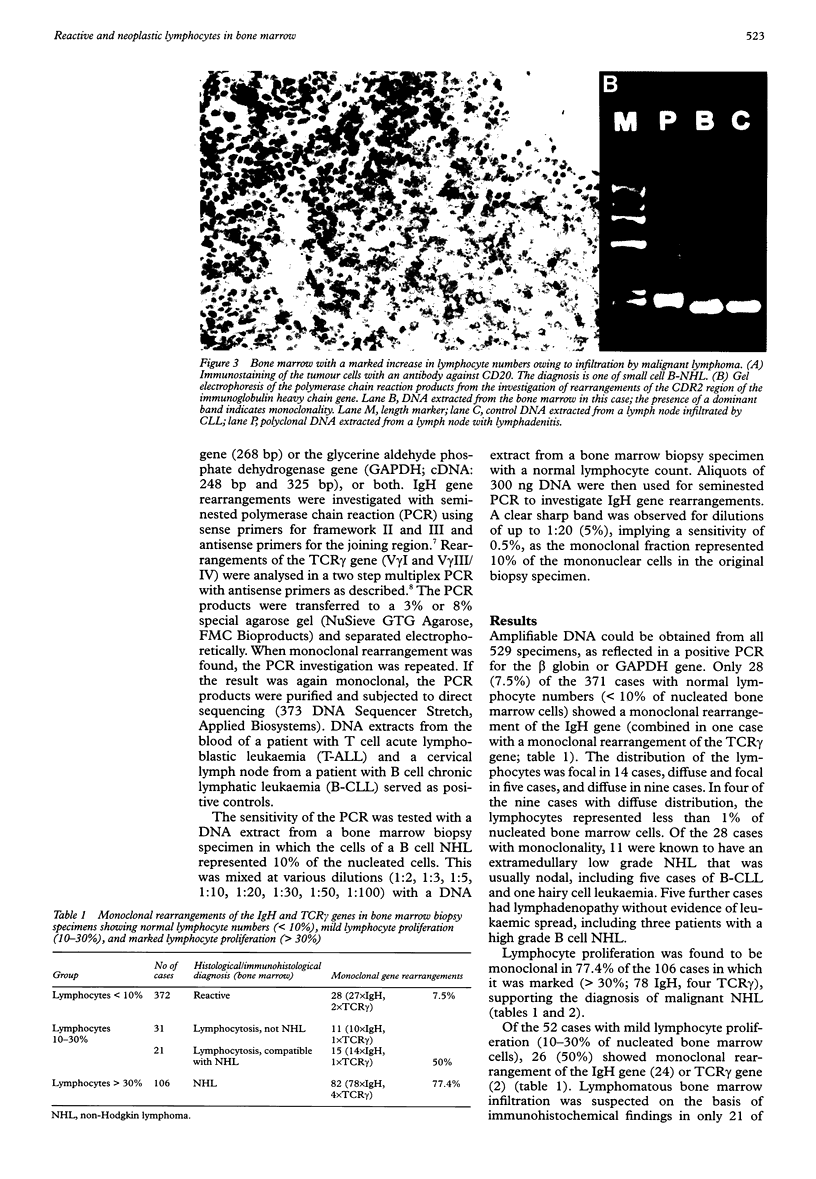Abstract
BACKGROUND: Slight, diffuse or focal lymphocyte proliferation is relatively common in bone marrow biopsy specimens. It may be impossible to determine whether this represents a reactive lymphocytosis or low grade non-Hodgkin lymphoma (NHL) on the basis of routine investigations alone. AIM: To investigate the supplementary use of molecular biological techniques in this situation. METHODS: 529 formalin fixed, paraffin embedded bone marrow biopsy specimens from the iliac crest were subjected to histological and immunohistochemical staining to determine the number and nature of the lymphocytes present. The cases were divided into three groups according to the lymphocyte count: normal (< 10% of nucleated bone marrow cells), slightly increased (10-30%), and markedly increased (> 30%). All of the last group could be diagnosed as NHL from the morphological findings alone. The clonality of rearrangements of the IgH and TCR gamma genes was investigated by polymerase chain reaction (PCR). RESULTS: Monoclonality was observed in 7.5% of the 372 cases with a normal lymphocyte count, in 50% of the cases with a modest increase in lymphocyte numbers (suggesting a diagnosis of low grade NHL not detected by immunostaining), and in 77% of the cases with markedly increased lymphocyte numbers. CONCLUSIONS: If PCR is used in addition to the immunohistochemical investigation of bone marrow biopsies, considerably more cases of NHL can be identified, making this of particular use in staging and detection of recurrences.
Full text
PDF





Images in this article
Selected References
These references are in PubMed. This may not be the complete list of references from this article.
- Abdel-Reheim F. A., Edwards E., Arber D. A. Utility of a rapid polymerase chain reaction panel for the detection of molecular changes in B-cell lymphoma. Arch Pathol Lab Med. 1996 Apr;120(4):357–363. [PubMed] [Google Scholar]
- Arnold A., Cossman J., Bakhshi A., Jaffe E. S., Waldmann T. A., Korsmeyer S. J. Immunoglobulin-gene rearrangements as unique clonal markers in human lymphoid neoplasms. N Engl J Med. 1983 Dec 29;309(26):1593–1599. doi: 10.1056/NEJM198312293092601. [DOI] [PubMed] [Google Scholar]
- Ashton-Key M., Diss T. C., Du M. Q., Kirkham N., Wotherspoon A., Isaacson P. G. The value of the polymerase chain reaction in the diagnosis of cutaneous T-cell infiltrates. Am J Surg Pathol. 1997 Jul;21(7):743–747. doi: 10.1097/00000478-199707000-00001. [DOI] [PubMed] [Google Scholar]
- Collins R. D. Is clonality equivalent to malignancy: specifically, is immunoglobulin gene rearrangement diagnostic of malignant lymphoma? Hum Pathol. 1997 Jul;28(7):757–759. doi: 10.1016/s0046-8177(97)90145-3. [DOI] [PubMed] [Google Scholar]
- Cossman J., Zehnbauer B., Garrett C. T., Smith L. J., Williams M., Jaffe E. S., Hanson L. O., Love J. Gene rearrangements in the diagnosis of lymphoma/leukemia. Guidelines for use based on a multiinstitutional study. Am J Clin Pathol. 1991 Mar;95(3):347–354. doi: 10.1093/ajcp/95.3.347. [DOI] [PubMed] [Google Scholar]
- Deane M., McCarthy K. P., Wiedemann L. M., Norton J. D. An improved method for detection of B-lymphoid clonality by polymerase chain reaction. Leukemia. 1991 Aug;5(8):726–730. [PubMed] [Google Scholar]
- Deane M., Norton J. D. Detection of immunoglobulin gene rearrangement in B lymphoid malignancies by polymerase chain reaction gene amplification. Br J Haematol. 1990 Mar;74(3):251–256. doi: 10.1111/j.1365-2141.1990.tb02579.x. [DOI] [PubMed] [Google Scholar]
- Delfau-Larue M. H., Petrella T., Lahet C., Lebozec C., Bagot M., Roudot-Thoraval F., Dalac S., Farcet J. P., Wechsler J. Value of clonality studies of cutaneous T lymphocytes in the diagnosis and follow-up of patients with mycosis fungoides. J Pathol. 1998 Feb;184(2):185–190. doi: 10.1002/(SICI)1096-9896(199802)184:2<185::AID-PATH997>3.0.CO;2-9. [DOI] [PubMed] [Google Scholar]
- Dick F., Bloomfield C. D., Brunning R. D. Incidence cytology, and histopathology of non-Hodgkin's lymphomas in the bone marrow. Cancer. 1974 May;33(5):1382–1398. doi: 10.1002/1097-0142(197405)33:5<1382::aid-cncr2820330525>3.0.co;2-2. [DOI] [PubMed] [Google Scholar]
- Diss T. C., Peng H., Wotherspoon A. C., Isaacson P. G., Pan L. Detection of monoclonality in low-grade B-cell lymphomas using the polymerase chain reaction is dependent on primer selection and lymphoma type. J Pathol. 1993 Mar;169(3):291–295. doi: 10.1002/path.1711690303. [DOI] [PubMed] [Google Scholar]
- Diss T. C., Watts M., Pan L. X., Burke M., Linch D., Isaacson P. G. The polymerase chain reaction in the demonstration of monoclonality in T cell lymphomas. J Clin Pathol. 1995 Nov;48(11):1045–1050. doi: 10.1136/jcp.48.11.1045. [DOI] [PMC free article] [PubMed] [Google Scholar]
- Ellison D. J., Hu E., Zovich D., Pinter-Brown L., Pattengale P. K. Immunogenetic analysis of bone marrow aspirates in patients with non-Hodgkin lymphomas. Am J Hematol. 1990 Mar;33(3):160–166. doi: 10.1002/ajh.2830330303. [DOI] [PubMed] [Google Scholar]
- Foucar K., McKenna R. W., Frizzera G., Brunning R. D. Bone marrow and blood involvement by lymphoma in relationship to the Lukes--Collins classification. Cancer. 1982 Mar 1;49(5):888–897. doi: 10.1002/1097-0142(19820301)49:5<888::aid-cncr2820490512>3.0.co;2-k. [DOI] [PubMed] [Google Scholar]
- Galoin S., al Saati T., Schlaifer D., Huynh A., Attal M., Delsol G. Oligonucleotide clonospecific probes directed against the junctional sequence of t(14;18): a new tool for the assessment of minimal residual disease in follicular lymphomas. Br J Haematol. 1996 Sep;94(4):676–684. doi: 10.1046/j.1365-2141.1996.7062323.x. [DOI] [PubMed] [Google Scholar]
- Gribben J. G., Freedman A. s., Woo S. D., Blake K., Shu R. S., Freeman G., Longtine J. A., Pinkus G. S., Nadler L. M. All advanced stage non-Hodgkin's lymphomas with a polymerase chain reaction amplifiable breakpoint of bcl-2 have residual cells containing the bcl-2 rearrangement at evaluation and after treatment. Blood. 1991 Dec 15;78(12):3275–3280. [PubMed] [Google Scholar]
- Gribben J. G., Neuberg D., Barber M., Moore J., Pesek K. W., Freedman A. S., Nadler L. M. Detection of residual lymphoma cells by polymerase chain reaction in peripheral blood is significantly less predictive for relapse than detection in bone marrow. Blood. 1994 Jun 15;83(12):3800–3807. [PubMed] [Google Scholar]
- Griesser H. Gene rearrangements and chromosomal translocations in T cell lymphoma--diagnostic applications and their limits. Virchows Arch. 1995;426(4):323–338. doi: 10.1007/BF00191340. [DOI] [PubMed] [Google Scholar]
- Han T., Ozer H., Gavigan M., Gajera R., Minowada J., Bloom M. L., Sadamori N., Sandberg A. A., Gomez G. A., Henderson E. S. Benign monoclonal B cell lymphocytosis--a benign variant of CLL: clinical, immunologic, phenotypic, and cytogenetic studies in 20 patients. Blood. 1984 Jul;64(1):244–252. [PubMed] [Google Scholar]
- Hsu S. M., Raine L., Fanger H. Use of avidin-biotin-peroxidase complex (ABC) in immunoperoxidase techniques: a comparison between ABC and unlabeled antibody (PAP) procedures. J Histochem Cytochem. 1981 Apr;29(4):577–580. doi: 10.1177/29.4.6166661. [DOI] [PubMed] [Google Scholar]
- Ilyas M., Jalal H., Linton C., Rooney N. The use of the polymerase chain reaction in the diagnosis of B-cell lymphomas from formalin-fixed paraffin-embedded tissue. Histopathology. 1995 Apr;26(4):333–338. doi: 10.1111/j.1365-2559.1995.tb00194.x. [DOI] [PubMed] [Google Scholar]
- Inghirami G., Szabolcs M. J., Yee H. T., Corradini P., Cesarman E., Knowles D. M. Detection of immunoglobulin gene rearrangement of B cell non-Hodgkin's lymphomas and leukemias in fresh, unfixed and formalin-fixed, paraffin-embedded tissue by polymerase chain reaction. Lab Invest. 1993 Jun;68(6):746–757. [PubMed] [Google Scholar]
- Jonsson O. G., Kitchens R. L., Scott F. C., Smith R. G. Detection of minimal residual disease in acute lymphoblastic leukemia using immunoglobulin hypervariable region specific oligonucleotide probes. Blood. 1990 Nov 15;76(10):2072–2079. [PubMed] [Google Scholar]
- Knowles D. M., Athan E., Ubriaco A., McNally L., Inghirami G., Wieczorek R., Finfer M., Jakobiec F. A. Extranodal noncutaneous lymphoid hyperplasias represent a continuous spectrum of B-cell neoplasia: demonstration by molecular genetic analysis. Blood. 1989 May 1;73(6):1635–1645. [PubMed] [Google Scholar]
- Kurokawa T., Kinoshita T., Ito T., Saito H., Hotta T. Detection of minimal residual disease B cell lymphoma by a PCR-mediated RNase protection assay. Leukemia. 1996 Jul;10(7):1222–1231. [PubMed] [Google Scholar]
- Lai H. S., Tien H. F., Hsieh H. C., Chen Y. C., Su I. J., Wang C. H., Liu M. C., Cheng A. L., Shen M. C., Liu C. H. Bone marrow involvement in non-Hodgkin's lymphoma. Taiwan Yi Xue Hui Za Zhi. 1989 Feb;88(2):114–121. [PubMed] [Google Scholar]
- Liang R., Chan V. V., Chan T. K., Todd D., Ho F. Immunoglobulin gene rearrangement in the peripheral blood and bone marrow of patients with lymphomas of the mucosa-associated lymphoid tissues. Acta Haematol. 1990;84(1):19–23. doi: 10.1159/000205021. [DOI] [PubMed] [Google Scholar]
- Ligler F. S., Smith R. G., Kettman J. R., Hernandez J. A., Himes J. B., Vitetta E. S., Uhr J. W., Frenkel E. P. Detection of tumor cells in the peripheral blood of nonleukemic patients with B-cell lymphoma: analysis of "clonal excess". Blood. 1980 May;55(5):792–801. [PubMed] [Google Scholar]
- Ludwig C. U., Gencik M., Shipman R. Multistep transformation in low-grade lymphoproliferative diseases. Ann Oncol. 1993 Dec;4(10):825–830. doi: 10.1093/oxfordjournals.annonc.a058387. [DOI] [PubMed] [Google Scholar]
- McCarthy K. P., Sloane J. P., Wiedemann L. M. Rapid method for distinguishing clonal from polyclonal B cell populations in surgical biopsy specimens. J Clin Pathol. 1990 May;43(5):429–432. doi: 10.1136/jcp.43.5.429. [DOI] [PMC free article] [PubMed] [Google Scholar]
- Navone R., Valpreda M., Pich A. Lymphoid nodules and nodular lymphoid hyperplasia in bone marrow biopsies. Acta Haematol. 1985;74(1):19–22. doi: 10.1159/000206157. [DOI] [PubMed] [Google Scholar]
- Provan A. B., Hodges E., Smith A. G., Smith J. L. Use of paraffin wax embedded bone marrow trephine biopsy specimens as a source of archival DNA. J Clin Pathol. 1992 Sep;45(9):763–765. doi: 10.1136/jcp.45.9.763. [DOI] [PMC free article] [PubMed] [Google Scholar]
- Ramasamy I., Brisco M., Morley A. Improved PCR method for detecting monoclonal immunoglobulin heavy chain rearrangement in B cell neoplasms. J Clin Pathol. 1992 Sep;45(9):770–775. doi: 10.1136/jcp.45.9.770. [DOI] [PMC free article] [PubMed] [Google Scholar]
- Trainor K. J., Brisco M. J., Wan J. H., Neoh S., Grist S., Morley A. A. Gene rearrangement in B- and T-lymphoproliferative disease detected by the polymerase chain reaction. Blood. 1991 Jul 1;78(1):192–196. [PubMed] [Google Scholar]
- Waldmann T. A. The arrangement of immunoglobulin and T cell receptor genes in human lymphoproliferative disorders. Adv Immunol. 1987;40:247–321. doi: 10.1016/s0065-2776(08)60241-2. [DOI] [PubMed] [Google Scholar]
- Weirich G., Funk A., Hoepner I., Heider U., Noll S., Pütz B., Fellbaum C., Höfler H. PCR-based assays for the detection of monoclonality in non-Hodgkin's lymphoma: application to formalin-fixed, paraffin-embedded tissue and decalcified bone marrow samples. J Mol Med (Berl) 1995 May;73(5):235–241. doi: 10.1007/BF00189923. [DOI] [PubMed] [Google Scholar]
- Zwicky C. S., Maddocks A. B., Andersen N., Gribben J. G. Eradication of polymerase chain reaction detectable immunoglobulin gene rearrangement in non-Hodgkin's lymphoma is associated with decreased relapse after autologous bone marrow transplantation. Blood. 1996 Nov 1;88(9):3314–3322. [PubMed] [Google Scholar]





